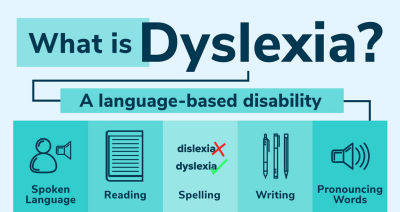Definition
To sum up dyslexia in simple terms, it is a learning disability in reading (Dyslexia Canada, 2023). Those who have it struggle with reading accurately and fluently, and some even have trouble with reading comprehension, spelling, and writing. The definition of dyslexia has evolved o9ver time, reflecting advances in research, and understanding of the condition (IDA, 2023), so there are a variety of provided definitions.
The current definition tells us it is a learning disability that is neurobiological in origin (Lyon, Shaywitz, & Shaywitz, 2002). The working definition from 1994 describes it as one several distinct learning disabilities (Lyon, Shaywitz, & Shaywitz, 2002). The International Dyslexia Association defines dyslexia formally, as a specific learning disability characterized by difficulties in accurate and fluent word recognition, spelling, and decoding abilities (IDA, 2023). The Yale Centre for Dyslexia and Creativity defines dyslexia in plain language to be an unexpected difficulty in learning to read, taking away from an individual's ability to read quickly and automatically.
It is a commonly known and accepted fact that children work at their own pace. However, a child who has been struggling with reading and spelling may have dyslexia. Signs and indicators of dyslexia can be seen as early as pre-school (Dyslexia Canada, 2023). Oftentimes, children that struggle with reading are dismissed as slow learners, unmotivated, or lazy.
Ten to twenty percent of the population has a language-based learning disability (IDA, 2023). Dyslexia is the most common cause of reading, writing, and spelling difficulties (Dyslexia Canada, 2023). It affects everyone equally regardless of gender, ethnic, and socio-economic backgrounds. It is a language processing disorder, so it can affect all forms of language, spoken and written (Nemours Foundation, 2022).
It is assumed to just be the reversal of letters and numbers in the eyes of a dyslexic person. However, that is a normal part of development and seen in many kids in the first or second grade. The main issue in dyslexia is recognizing phonemes, which are the basic sounds of speech. For example, the "b" sound in "bat" is phoneme (Nemours Foundation, 2022). Making the connection between the sound and letter symbol or the sound, and to blend sounds into words is a struggle. It takes a lot of time for a person with dyslexia to sound out a word because word reading takes more time and focus, and the meaning of the word is often lost (Nemours Foundation, 2022).
